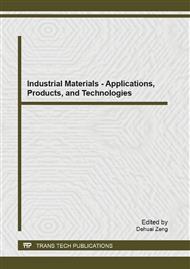[1]
M. Fischer: Merkblatt 434: Wetterfester Baustahl. Stahl-Informations-Zentrum. 39 p. (2004).
Google Scholar
[2]
T.P. Lang, J.P. Lebet: Brücken aus wetterfestem Stahl. Tec 21, Volume 24: 23-29 (2002).
Google Scholar
[3]
EN 10025-5: 2004 Hot rolled products of structural steels – Part 5: Technical delivery conditions for structural steels with improved atmospheric corrosion resistance. CEN (2004).
DOI: 10.3403/30239486
Google Scholar
[4]
EN 1990: 2002 Eurocode: Basis for structural design. CEN (2004).
Google Scholar
[5]
EN 1993-1-1: 2005 Eurocode 3: Design of steel structures – Part 1-1: General rules and rules for buildings. CEN (2005).
DOI: 10.1680/dgte3.31630
Google Scholar
[6]
P. Janas, M. Krejsa., V. Krejsa.: Using the Direct Determined Fully Probabilistic Method (DDFPM) for determination of failure, Reliability, Risk And Safety: Theory And Applications (Vols 1-3), pp.1467-1474, Prague, Czech Republic (2010).
DOI: 10.1201/9780203859759.ch203
Google Scholar
[7]
V. Krivy, P. Marek: Zur probabilistischen Bemessung von Stahlrahmen, Stahlbau 76 (1): 12-20 (2007).
DOI: 10.1002/stab.200710003
Google Scholar
[8]
D. Novak., M. Vorechovsky, R. Rusina: Small-sample probabilistic assessment - FREET software, in Proc. of the 9th International Conference on Applications of Statistics and Probability in Civil Engineering, San Francisco, USA (2003).
Google Scholar
[9]
The JCSS Probabilistic Model Code. [online]. http: /www. jcss. ethz. ch (2001).
Google Scholar
[10]
M. Fajkus, J. Melcher., M. Holicky, L. Rozlivka: Design characteristics of structural steels based on statistical analysis of metallurgical products, in Proc. of the Eurosteel 2002 conference, Coimbra, Portugal (2002).
Google Scholar
[11]
EN 1993-2: 2006 Eurocode 3: Design of steel structures – Part 2: Steel bridges. CEN (2006).
Google Scholar
[12]
P. Konecny, J. Brozovsky, V. Krivy: Simulation Based Reliability Assessment Method using Parallel Computing, in Proc. of The first international conference on parallel, distributed and grid computing for engineering, Pecs, Hungary (2009).
DOI: 10.4203/ccp.90.38
Google Scholar
[13]
D.Q. Li, S.B. Wu, C.B. Zhou, K.K. Phoon: Performance of translation approach for modeling correlated non-normal variables. Structural safety 39: 52-61 (2012).
DOI: 10.1016/j.strusafe.2012.08.001
Google Scholar
[14]
ASTM C101-04: 2004 Guide for Estimating the Atmospheric Corrosion Resistance of Low-Alloy Steels. ASTM International, USA (2004).
Google Scholar
[15]
V. Krivy, L. Fabian: Calculation of corrosion losses on weathering steel structures, Applied Mechanics and Materials 188: 177-182 (2012).
DOI: 10.4028/www.scientific.net/amm.188.177
Google Scholar


